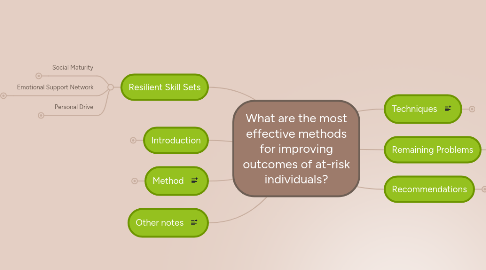
1. Resilient Skill Sets
1.1. Social Maturity
1.1.1. Positive social orientation
1.1.2. Peer acceptance
1.1.3. Self-regulation
1.2. Emotional Support Network
1.2.1. Responsive parent-child interactions
1.2.1.1. Proportion of positive interactions w/child
1.2.2. Stimulating home environment
1.2.2.1. Positive & stimulating Home Environment
1.2.3. Competent adult mentors
1.3. Personal Drive
1.3.1. Motivated to learn
1.3.2. Problem-solving skills
1.3.3. Sense of self-efficacy
2. Techniques
2.1. Content-Based Methods
2.1.1. Home Visitation Programs
2.1.1.1. Positive maternal interactions
2.1.1.2. Reduced risk of maltreatment and DV
2.1.1.3. Better health over lifetime
2.1.1.4. Reduced behavior problems
2.1.1.5. Reduced high school drop-out rates
2.1.1.6. Features of program
2.1.2. PATHS
2.1.2.1. Reduced emotional problems
2.1.2.2. Reduced conduct problems
2.1.2.3. Reduced hyperactivity
2.1.2.4. Reduced peer problems
2.1.2.5. Increased consideration
2.1.2.6. Reduced aggression
2.1.2.7. Increased prosocial behavior
2.1.2.8. Program features
2.1.3. Incredible Years
2.1.3.1. Decrease behavior problems
2.1.3.2. Increase parent-child interaction
2.1.3.3. Increased academic engagement
2.1.3.4. Increased school competence
2.1.3.5. Increased positive conflict management skills
2.1.3.6. Increased social skills with peers
2.1.3.7. Uses praise in parent education
2.2. Interaction-Based Methods
2.2.1. Play
2.2.1.1. Develop peer bonds
2.2.1.2. Social maturity (self-awareness)
2.2.1.3. Group Play
2.2.1.3.1. Prosocial skills
2.2.1.3.2. Improve social skills
2.2.1.3.3. Self-regulation
2.2.1.4. Play Therapy
2.2.1.4.1. Coping skills
2.2.2. Good Behavior Game
2.2.2.1. Reduces externalizing behavior
2.2.2.2. Long-term results if used consistently
2.2.2.3. Support service use
2.2.2.4. Approach to learning
2.2.2.5. Reduced rate of suicide ideation in emerging adulthood
2.2.3. Sensitive and Responsive Caregiver
2.2.3.1. Sensitivity
2.2.3.2. Praise
2.2.3.2.1. Positive v. Negative remarks
2.2.3.2.2. Subtle Linguistic Cues in Praise
2.2.3.2.3. Nonverbal and verbal praise
2.2.3.2.4. Nongeneric praise
2.2.3.2.5. Specific praise
2.2.3.3. Positive relationship compensatory for attention difficulties
2.2.3.4. Support
2.2.3.5. Positive behavior strategies
2.3. Implementation
2.3.1. Community-Family Link
2.3.1.1. Mentorship programs
2.3.1.1.1. Increase positive future orientation
2.3.1.1.2. Big Brothers/Big Sisters
2.3.1.1.3. Afterschool programs with competent adults (4-H)
2.3.1.1.4. Works for a range of ages and with groups or one on one
2.3.1.2. Parent Education
2.3.1.3. Quality Childcare
2.3.1.3.1. Access to quality schools and childcare
2.3.2. General Characteristics
2.3.2.1. Link emotional and motivation arousal with activities that promote executive functions
2.3.2.2. Generalizability
3. Remaining Problems
3.1. Factors not studied/addressed
3.1.1. Self-Efficacy (by age 18)
3.1.2. Motivation
3.1.3. Emotional support (by age 10)
3.1.4. Autonomy (by age 2)
3.2. Proper/effective use of proven methods
3.3. Current Number of Programs by Type
4. Recommendations
4.1. Cross-disciplinary
4.1.1. Creative techniques
4.1.1.1. Outdoors program
4.1.1.2. Creative teaching of coping using CBT concepts
4.1.1.2.1. Art therapy
4.1.1.3. Mindfulness
4.1.2. Therapeutic techniques
4.1.2.1. Play therapy
4.2. Adaptability
4.2.1. Universal Integration
4.2.1.1. Longer-term impact
4.2.2. Collaborative
4.3. Accessibility
4.3.1. Unbundling
4.3.1.1. Infant Contingency Learning
4.3.2. UIP
4.4. Evaluative
4.4.1. Standardization
4.4.1.1. Guide for implementing basic, effective methods
4.4.2. Evidence-Based
4.4.2.1. Mirroring
5. Introduction
5.1. Definitions
5.1.1. Riskfactors
5.1.2. Protective Factors
5.1.3. Resiliency
5.1.4. Negative outcomes/Positive outcomes
5.2. Early is essential
5.2.1. Unequal opportunities starting at birth
5.2.2. Children
5.2.3. Risks Build over time
5.2.4. At risk of...
6. Method
6.1. Identifying Protective Factors
6.1.1. "Valid" factors
6.2. Identifying Programs/Techniques
6.2.1. Evidence-Based Definition
6.2.2. Sources/Qualifications of Programs
6.2.2.1. Coalition for Evidence-Based Research
6.2.2.2. Blueprints
6.2.2.3. Office of Juvenile Justice and Delinquency Prevention
6.2.3. Sources for Techniques and Implementation
6.2.3.1. Aspects of programs
6.2.3.2. Same databases as programs
6.2.3.3. Searching for specific protective outcomes

